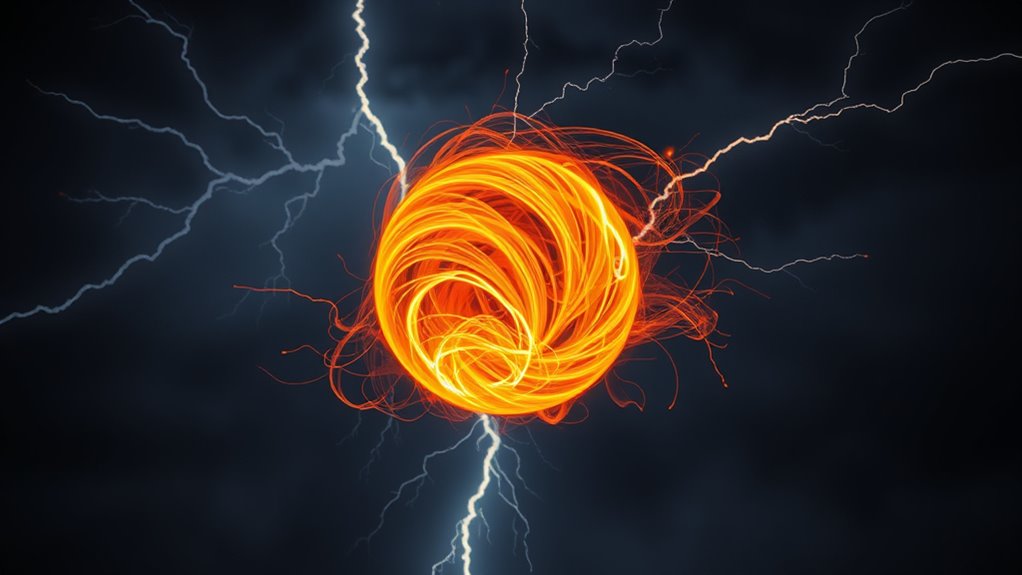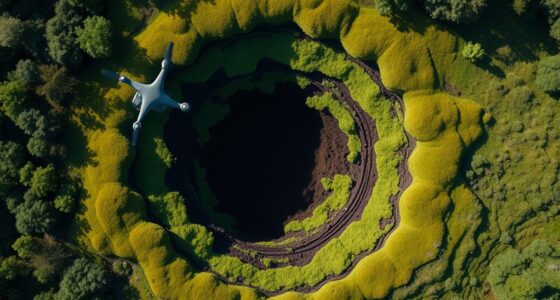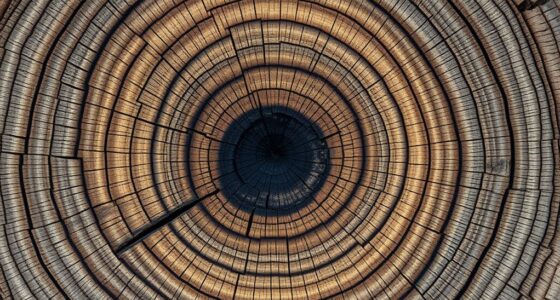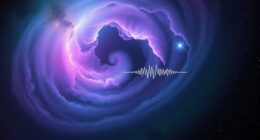A physics breakthrough shows that ball lightning forms through intense electric fields, like from lightning strikes, creating a plasma—hot, ionized gas—that becomes confined and stabilized into a spherical shape by electromagnetic forces. These fields generate magnetic effects that trap and sustain the plasma, allowing the ball to hover and gradually fade. If you’re curious about the detailed process behind this fascinating phenomenon, you’ll discover more as you explore further.
Key Takeaways
- Lightning strikes or strong electric fields create plasma, which becomes confined into a spherical shape through electromagnetic forces.
- Intense electric fields generate magnetic fields that trap and stabilize the plasma, forming the ball lightning structure.
- Electromagnetic interactions induce currents within the plasma, producing light, heat, and maintaining the shape.
- Feedback between plasma and electromagnetic fields sustains the luminous, hovering, and gradually fading behavior.
- The process demonstrates ball lightning as a complex plasma phenomenon driven by electromagnetic dynamics, not an illusion.
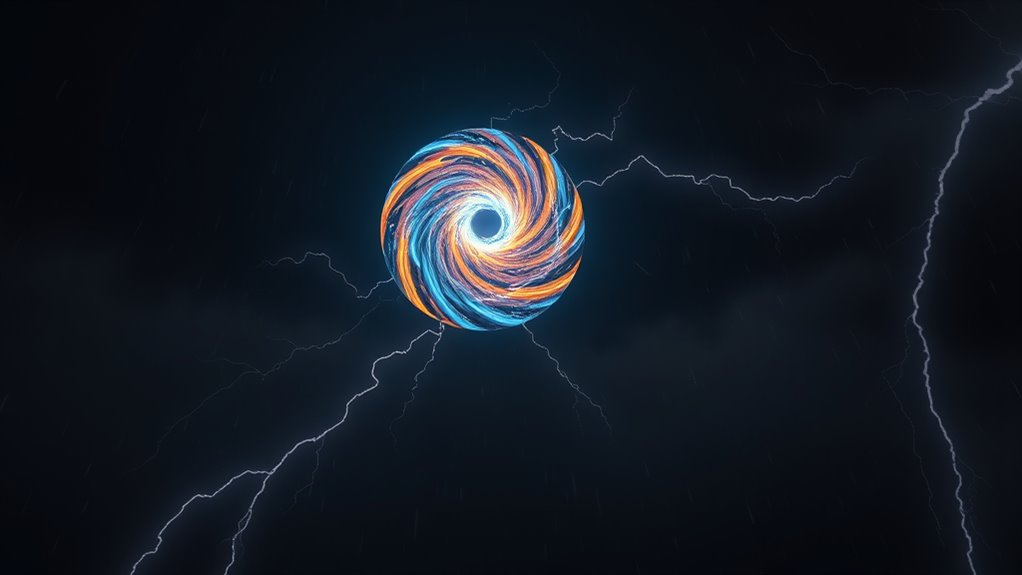
Could this latest physics breakthrough change the way we comprehend the universe? Researchers have recently made significant progress in understanding how ball lightning forms, a mysterious atmospheric phenomenon that has puzzled scientists for centuries. This discovery hinges on deep insights into plasma dynamics and electromagnetic phenomena, revealing that ball lightning isn’t just a fleeting optical illusion but a complex interaction of charged particles and electromagnetic fields. This insight into plasma behavior provides a foundation for further exploration of natural electrical phenomena. As you explore this breakthrough, you’ll see that it offers a window into the behavior of plasmas in natural settings, expanding our knowledge of both atmospheric physics and fundamental forces.
At its core, the new research shows that ball lightning forms through a process involving plasma dynamics. When lightning strikes or a strong electric field exists in the atmosphere, it creates a plasma—a hot, ionized gas composed of free electrons and ions. But what sets ball lightning apart is how this plasma becomes confined and stabilized into a glowing, spherical shape. The scientists have identified that electromagnetic phenomena play a critical role here: the intense electric fields generate magnetic fields that can trap and contain the plasma, preventing it from dispersing immediately. This self-sustaining electromagnetic structure allows the ball to hover and slowly fade away, sometimes lasting several seconds.
Understanding these plasma interactions helps clarify the conditions necessary for ball lightning to form. You’ll learn that the electromagnetic phenomena involved are highly dynamic, with fluctuating electric and magnetic fields influencing the stability and motion of the plasma ball. These fields can induce currents within the plasma, which in turn produce the light and heat observed during a lightning event. The interplay creates a feedback loop: the plasma’s behavior reinforces the electromagnetic fields, maintaining the ball’s shape and brightness until it dissipates or interacts with objects in its path.
Electromagnetic fields dynamically influence plasma stability, creating feedback loops that sustain ball lightning’s shape and glow.
This breakthrough isn’t just about explaining a rare atmospheric display—it opens doors for exploring plasma behavior more broadly, from controlled fusion experiments to space physics. By understanding how electromagnetic phenomena confine and sustain plasma, scientists can develop better models of natural phenomena and potentially harness similar effects for technological advancements. You might consider how these principles could inform future innovations in energy or materials science, or how they help us grasp the universe’s more extreme environments, like stellar atmospheres or cosmic plasmas. Ultimately, this discovery challenges previous assumptions and invites a new perspective on the interplay of plasma dynamics and electromagnetic phenomena, bringing us closer to mastering the secrets of the universe’s most elusive phenomena.
Frequently Asked Questions
Can Ball Lightning Be Artificially Created in Laboratories?
You might wonder if ball lightning can be artificially created in labs. Researchers are actively working on experimental replication, trying to produce this elusive phenomenon. While some experiments mimic atmospheric conditions that could generate ball lightning, success remains limited. You should know that scientists are still exploring various methods, and although progress is promising, fully replicating ball lightning outside natural environments hasn’t been achieved yet.
How Long Does a Typical Ball Lightning Last?
You wonder about ball lightning duration and its lifespan measurement. Typically, ball lightning lasts from a few seconds to around 10 seconds, though some reports suggest it can persist longer. Its lifespan varies based on environmental conditions and energy sources. Scientists find it challenging to measure precisely, but most observations indicate a brief, fleeting existence. So, expect it to vanish quickly, usually within a handful of seconds.
Is Ball Lightning Dangerous to Humans or Property?
Think of ball lightning as a mysterious firework in the sky—beautiful but unpredictable. It can be dangerous to humans because of electrical hazards, potentially causing burns or shocks. It also risks property damage if it strikes buildings or electrical equipment. While rare, it’s best to stay cautious around it, as its erratic nature makes it a wild card that could turn a mesmerizing sight into a harmful one.
What Materials Are Most Susceptible to Attracting or Generating Ball Lightning?
You might notice that materials with high electrical conductivity, like metals, are more susceptible to attracting or generating ball lightning. The material composition plays a key role; metals easily conduct electrical energy, making them prime candidates for interaction. Conversely, insulators are less affected. So, if you’re working with conductive materials, stay cautious, as they can attract or even trigger ball lightning due to their electrical properties.
Are There Any Confirmed Cases of Ball Lightning Causing Damage?
Historical reports of ball lightning causing damage are rare but intriguing, fueling ongoing scientific skepticism. You might find it surprising that only a handful of documented incidents have verified injuries or property destruction, making it a mysterious phenomenon. While some accounts suggest harm, the lack of consistent evidence keeps experts cautious. This uncertainty highlights the need for further research to confirm whether ball lightning can genuinely cause damage or remains a fascinating anomaly.
Conclusion
Now, imagine witnessing ball lightning and knowing science finally reveals its secrets. This breakthrough confirms that complex physics can unravel nature’s mysteries, making you feel awe and wonder. You realize that what once seemed inexplicable is now within grasp, inspiring hope for future discoveries. Trust that as scientists continue to explore, they’ll unfasten even more astonishing phenomena, reminding you that curiosity and persistence can truly transform our understanding of the universe.
